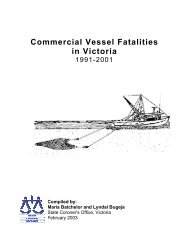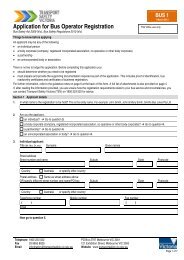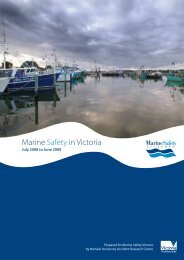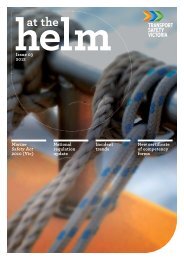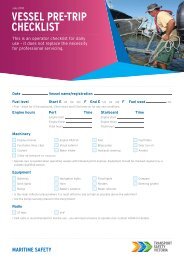Marine Safety in Victoria Report 2007-2008 (PDF, 1.3 MB, 72 pp.)
Marine Safety in Victoria Report 2007-2008 (PDF, 1.3 MB, 72 pp.)
Marine Safety in Victoria Report 2007-2008 (PDF, 1.3 MB, 72 pp.)
You also want an ePaper? Increase the reach of your titles
YUMPU automatically turns print PDFs into web optimized ePapers that Google loves.
5.5.2 Motor boat<strong>in</strong>g and boat<strong>in</strong>g not specified (n=279)<br />
There were 41 hospital admissions and 238 ED presentations for <strong>in</strong>juries that occurred <strong>in</strong> recreational<br />
motor boat<strong>in</strong>g and ‘other’ recreational boat<strong>in</strong>g. The type of vessel <strong>in</strong>volved <strong>in</strong> these <strong>in</strong>jury <strong>in</strong>cidents is not<br />
recorded on the VAED or well recorded on the VEMD.<br />
5.5.2.1 Hospital admissions (n = 41)<br />
Motor boat<strong>in</strong>g and general boat<strong>in</strong>g (not specified) cases accounted for 18% of all hospital admissions for<br />
recreational boat<strong>in</strong>g-related <strong>in</strong>juries. Males were over-represented <strong>in</strong> cases (70%). Admissions peaked <strong>in</strong><br />
45-49 year olds (20%), followed by 60-64 year olds (15%) then 40-44 year olds (10%).<br />
Injuries were most commonly to the lower extremity (34%), followed by the trunk (22%), the u<strong>pp</strong>er<br />
extremity (20%) and the head/face/neck (15%). Fractures accounted for 59% of hospitalisations, followed<br />
by dislocation/spra<strong>in</strong>/stra<strong>in</strong> (10%), <strong>in</strong>jury to muscle or tendon (7%) and open wounds (5%). The most<br />
common specific <strong>in</strong>juries were: lower knee and lower leg fracture (20%), rib fracture (10%) and elbow/<br />
forearm fracture (7%).<br />
Thirty-two percent of cases were admitted to hospital for less than 2 days, 61% stayed 2-7 days and 7%<br />
(n=3 cases) stayed 8-30 days. The longest stays (11, 14 and 15 days) were related to neck, hip and thigh<br />
and knee and lower leg <strong>in</strong>jury (fracture or <strong>in</strong>jury to muscle/tendon).<br />
The VAED does not <strong>in</strong>clude any descriptive data on the circumstances of the <strong>in</strong>jury. However, some<br />
admissions are also recorded on the VEMD and narrative data on these cases provide some details on the<br />
circumstances of the <strong>in</strong>jury. Injury scenarios <strong>in</strong>cluded:<br />
• Trips/slips/falls: Fell when boat buffeted by wave/rough sea; Lost foot<strong>in</strong>g, fell onto bar; Fell down steps<br />
while at party on cruise boat; Fell from steps on fly bridge onto swim platform then concrete; Fell<br />
off boat onto trailer; Fell <strong>in</strong>to water; Fell when boat hit pylon; Fell off top deck of houseboat; Tri<strong>pp</strong>ed<br />
carry<strong>in</strong>g a 100kg boat motor; Tri<strong>pp</strong>ed and fell; Sli<strong>pp</strong>ed climb<strong>in</strong>g off boat; Sli<strong>pp</strong>ed on wet pier ty<strong>in</strong>g up<br />
boat.<br />
• Hit/struck/crushed: Hand caught/crushed <strong>in</strong> boat eng<strong>in</strong>e/bait box; Hand caught between boat and<br />
ramp/car and boat trailer/ boat and jetty/ two boats/boat trailer; Foot caught <strong>in</strong> rope; Person crushed<br />
when on front of boat and the boat moved forward; Person crushed between boat and other object;<br />
Person hit by a boat.<br />
• Cutt<strong>in</strong>g/pierc<strong>in</strong>g: Cut by boat cha<strong>in</strong>; Cut leg.<br />
• Burn: Burnt by heater when it caught fire; Contact burn when fuel leaked and ignited.<br />
5.5.2.2 ED presentations (non-admissions) (n = 238)<br />
There was a 7% decrease <strong>in</strong> the number of ED presentations for motorised and general boat<strong>in</strong>g <strong>in</strong> 2006/7<br />
(n=238) compared with 2005/6 (n=255 cases).<br />
Just over two-thirds of the ED presentations were male (67%). Half were aged 30-49 years and a further<br />
quarter aged 15-29 years. Forty percent of <strong>in</strong>juries were to the lower extremity, 27% to the u<strong>pp</strong>er<br />
extremity, 16% to the head/face/neck and 11% to the trunk. The hand, <strong>in</strong>clud<strong>in</strong>g f<strong>in</strong>gers (14%), lower leg<br />
(13%), foot, <strong>in</strong>clud<strong>in</strong>g toes (10%); and head, exclud<strong>in</strong>g face (9%) were the most common specific <strong>in</strong>jury<br />
sites. The most common <strong>in</strong>jury diagnoses were: open wounds (34%); spra<strong>in</strong>s/stra<strong>in</strong>s (15%); fracture/<br />
dislocation (14%); superficial <strong>in</strong>jury (13%); crush <strong>in</strong>jury (6%); and <strong>in</strong>jury to muscle/tendons (5%).<br />
<strong>Mar<strong>in</strong>e</strong> <strong>Safety</strong> <strong>in</strong> <strong>Victoria</strong>: July <strong>2007</strong> to June <strong>2008</strong> 55





